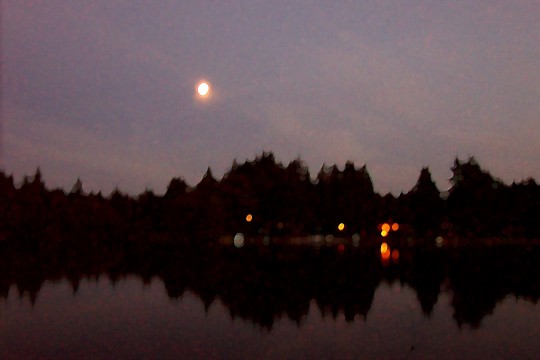Life at the Lake
a diary of living at a small lowland lakeWHAT IT'S LIKE

Early moonrise over Lake Ketchum
|
Archive Search |
| Links |
|
and s-integrator |
In August my wife and I retired to the country from our home in Seattle; we owned riverfront property we intended to build on, but decided after a trial run in an old mobile home that we'd rather be on a quiet body of water, that is, a lake. The river was badly degraded, mostly by old logging activity, and the water ran clay-colored most of the year. That is, we could not count on having a clear river at our doorstep, and the attendant good fly fishing of old, during any month except mid-summer.
Our search began late in winter, and by spring we had closely examined a number of small (this was our preference) lakes in Northern Snohomish County in Washington State. One by one we decided against them, though each had its particular charm?either house or lake. Finally, a realtor we knew found a house he thought we'd like on a lake that was not known to us. When he described it to us, I immediately decided he was wrong?it was not our kind of place. Mostly to humor him, we agreed to drive out to see it on a warm Saturday morning. It was new on the market, he said, and would be sold in a matter of a few days. Ha, ha, I opined. We had heard that story before.
We saw it and fell in love it--both the lake and the house. The realtor was right. We didn't want to let it get away from us. The money was found and we bought it. The lake has seven species of fish, including rainbow trout. I was determined to catch all seven species, especially the last named, as quickly as possible. And I did. There we have been--on Lake Ketchum--ever since.
Note: you may notice some seasonal dissonance at first. I started these journals in autumn, and it is now spring, when I first publish them. Bear with me, please. It won't hurt for long. Robert C. Arnold
1
A stormy day, we are visited by a heterogeneous group of waterfowl along our grassy beach. For weeks now, these guys have been grazing the shallows of the lake, gobbling up the dying vegetation--mostly Elodea and the last of the dying duckweed and its look-alike cousin, the Mexican water fern.
I sort out the following: two pairs of mallards (most ordinary), eight coots, six American widgeons (four females and two males, unpaired, the males showing up only recently, with their shiny pates), and four female northern shovelers, but with nary a male in attendance all autumn. Evidently the males are all off somewhere together. (Playing cards, drinking beer, smoking cigars?)
All the ducks are surface feeders, but the species vary somewhat in their habits. For instance, the mallards and widgeons will invert, turn tail-up, in order to reach deeper weed in the shallows. So will the platypus-billed shovelers, but they have less far to descend before touching grubby bottom. The coots will actually dive to grab the matted green. I've never timed them, but I'm sure they stay submerged a full minute or more.
On shore coots are odd-looking birds, with their whitish beak and bulbous body. You'd think they'd have trouble flying and they do. It is easy to pick them out in flight, for they buzz along the water, unable or not choosing to soar. They skitter, they flutter, they fan the water with their feet and wings, they churn the water, both taking off and landing, usually not far away from their starting point.
I ask Norma what color feet they have, these soft black coots, and she replies, "Green?" So be it, though I don't remember seeing any duck with such feet. It is only when there is a windstorm, such as now, that they and the others waddle ashore. Clearly none of the ducks are meant to be landlubbers. They strut most awkwardly, their upturned tails nearly rubbing the ground.
For now it is the shoreline they all occupy, stepping in and out of it. Occupants neither of the deep water nor the land, they miserably occupy the nether region. It is the chop they shun.
In spring I'd say they were feeding on the snails and other crustaceans they find along the marginal edge, but now it is deep autumn those creatures are dormant or dying. When the days get longer (soon, soon), the seed or larvae of such things will germinate and spring into life. For now the ducks can find only the matted brown weed, or perhaps the newly exposed roots, white threads twined among the gravel. Ducks hurry along the process of breaking down the organic matter into its elements and making it disappear by degrees. This is what the lake needs now.
Shotguns boom off in the distance. It is the wildfowl hunting season. A duck that has been eating this fetid weed must have a terrible taste. One bite and the rest of the bird goes into the garbage. Is this another form of recycling?
Meanwhile the feeding ducks relieve themselves in the lake, adding to its already noxious phosphorous burden.
- - Comments ()
...